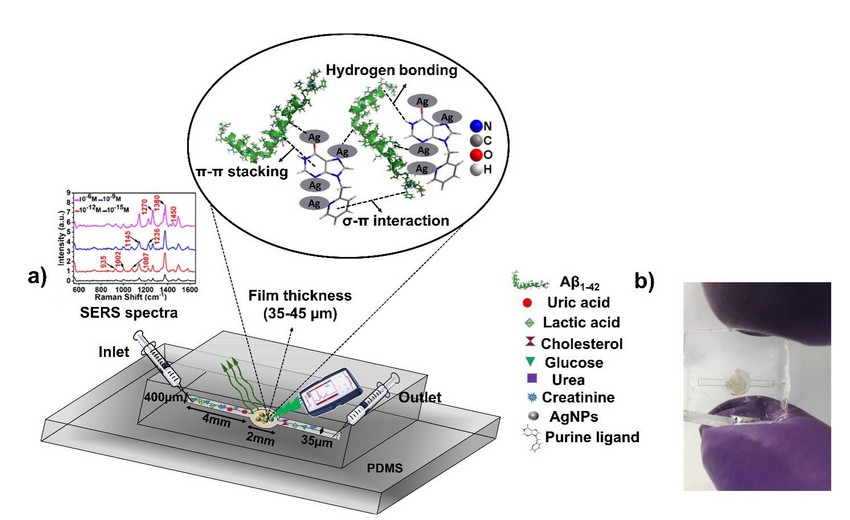Research Summary: We developed a microfluidic device for highly sensitive and selective detection of Aβ1-42, a biomarker of AD, in simulated cerebrospinal fluid (CSF) using Surface Enhanced Raman Spectroscopy (SERS).
Author interview

Ankita Jaiswal, a FARE Fellow, earned her PhD in Bioorganic Chemistry at IIT Kanpur, under the supervision of Prof. Sandeep Verma. Her doctoral research focuses on the development of novel materials for the fabrication of microfluidic devices for highly sensitive and selective detection of protein biomarkers for neurodegenerative disorders.
Lab: Prof. Sandeep Verma, Indian Institute of Technology Kanpur
Lab website: https://home.iitk.ac.in/~sverma/
What was the core problem you aimed to solve with this research?
The core problem solved by this research work has been the early detection of AD. Aβ1-42 oligomers can be seen decades before the actual symptoms of AD become apparent. Thus, if these misfolded protein oligomers are detected before the onset of symptoms, this debilitating disease can be managed better. Current detection methods are either invasive, expensive, or lack sensitivity at early stages of the disease. Using our developed microfluidic device, we can identify Aβ1-42 at early or presymptomatic stages with high sensitivity and selectivity, enabling timely intervention and potentially preventing the severe progression of the disease.

How did you go about solving this problem?
To address the challenge of early-stage AD detection, we developed a SERS-based microfluidic device to screen Aβ1-42 in a simulated CSF mixture, containing seven major components of CSF. The device was fabricated using photolithography and soft lithography methods on polydimethylsiloxane (PDMS). The CSF mixture was injected through a syringe needle at the inlet end, and after screening the target biomarker Aβ1-42 at the detection platform, the remaining components of the complex detection mixture were flushed out from the outlet end. The selectivity and sensitivity achieved by our device provide a strong motivation to further develop and refine the platform for clinical samples.
This study reports a microfluidic SERS platform for highly sensitive and selective detection of Aβ1–42, offering a promising tool for future point-of-care detection of Alzheimer’s disease. — Prof. Sandeep Verma
How would you explain your research outcomes (Key findings) to the non-scientific community?
AD is a neurodegenerative disorder that leads to memory loss, mood swings, forgetfulness, and difficulty in recognition, ultimately reducing the quality of life. As the disease progresses, it becomes life-threatening; therefore, its detection at an early or presymptomatic stage is crucial for effective healthcare management. Biomarkers, which are measurable indicators of disease, play a key role in early diagnosis. However, these biomarkers are usually present in very low concentrations during the initial stages, making them difficult to detect. Identifying such ultra-low concentrations can help manage the disease before severe damage occurs. In the case of AD, conventional methods like enzyme-linked immunosorbent assay and imaging techniques often detect biomarkers only at higher concentrations, by which time the disease has already advanced. SERS offers a powerful alternative, as it can identify the unique fingerprint of molecules and even detect single molecules with high sensitivity. One such biomarker of AD, Aβ1-42, can appear at extremely low concentrations decades before symptoms become apparent. To address this, we developed a SERS-based microfluidic device capable of highly sensitive and selective detection of Aβ1-42 in complex mixtures such as CSF. The SERS spectra obtained using this device demonstrated excellent reproducibility and minimal background noise, confirming the robustness of the platform. Thus, our developed device holds strong potential for early-stage AD detection and improved therapeutic outcomes.
What are the potential implications of your findings for the field and society?
The major challenge with AD lies in its late diagnosis. In most cases, the condition is identified only after it has progressed to advanced stages, characterized by widespread deposition of amyloid plaques and neurofibrillary tangles in the brain. These pathological changes result in extensive nerve cell death and significant brain shrinkage, leading to severe memory loss, impaired communication, and complete dependence on others for daily activities. At this stage, treatment options are restricted to symptomatic relief, as no drugs are currently available that can effectively halt or reverse the neurodegenerative process.
This underscores the importance of early detection, particularly of Aβ1–42, a key biomarker of AD. Reliable identification of this biomarker at the presymptomatic stage using our microfluidic-SERS device could enable timely intervention and improved management strategies well before current clinical methods allow. To the best of our knowledge, this study is the first to demonstrate reproducible, noise-free SERS readouts from a complex biological mixture using a fabricated microfluidic platform. The device not only offers rapid detection and requires minimal sample volume but also holds strong potential for integration into point-of-care (POC) testing with real clinical samples. Collectively, this advancement presents a promising step toward accessible, cost-effective diagnostics and has the potential to significantly reduce the societal and economic burden associated with neurodegenerative disorders.
What was the exciting moment during your research?
The most exciting moment in my research came when we first obtained a noise-free and reproducible SERS signal that could be directly attributed to Aβ1–42 within the microfluidic platform. To the best of our knowledge, this is the first case study in which a purine ligand was used for the specific binding of Aβ1–42. Achieving this was particularly significant because one of the main challenges we faced was ensuring both high sensitivity and selective detection in the presence of seven major components of CSF that often produce interfering signals.
Observing those distinct spectral peaks of Aβ1–42 not only confirmed that our purine-impregnated substrate was functioning as intended but also provided strong validation of our overall design strategy. This result was exciting because it transformed the project from a conceptual framework into a practical proof-of-principle, highlighting the potential of the platform to be developed further for early and reliable AD diagnostics for clinical samples.
Paper reference: Jaiswal, S. Mishra, P. K. Dwivedi, S. Verma. SERS-Based Microfluidic Bioscreening Platform for Selective Detection of β-Amyloid Peptides. Langmuir 2024, 40, 24463-24470. https://doi.org/10.1021/acs.langmuir.4c03042
Patent: A Microfluidic Device for Selective Surface Enhanced Raman Spectroscopy Based Detection of a Target Biomarker. A. Jaiswal, S. Mishra, P. K. Dwivedi, S. Verma (Indian Patent No: 547959, Granted on August 16, 2024).
Explore more
🎤 Career – Real career stories and job profiles of life science professionals. Discover current opportunities for students and researchers.
💼 Jobs – The latest job openings and internship alerts across academia and industry.
📢 Advertise with BioPatrika – Reach the Right Audience, Fast!
🛠️ Services – Regulatory support, patent filing assistance, and career consulting services.





Great Job done
Glad you liked it.